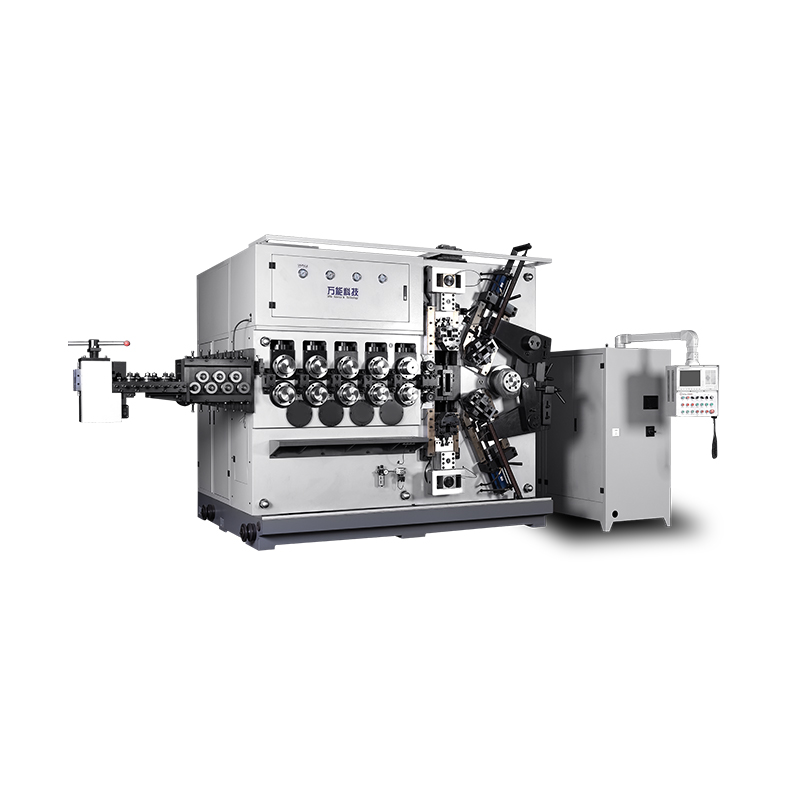Maintaining a spring coiling machine is crucial for ensuring its longevity and optimal performance. Routine maintenance helps prevent unexpected breakdowns, reduces downtime, and ensures the production of high-quality springs. Here's a detailed guide on the routine maintenance procedures for a spring coiling machine:
Daily Inspection
Lubrication: Check and ensure that all moving parts are adequately lubricated. The machine's manual will specify the type of lubricant and the points that need regular lubrication, such as bearings, slides, and gears.
Cleaning: Wipe down the machine to remove any dirt, dust, or debris. Pay special attention to the coiling head and feed rollers, as dirt can affect the accuracy and quality of the spring.
Check Tooling: Inspect the tooling, such as the coiling points, arbor, and cutting tools, for any signs of wear or damage. Replace or sharpen as necessary.
Tension Control: Verify that the tension of the wire feed is consistent and within the recommended range. Irregular tension can lead to defective springs.
Weekly Maintenance
Alignment Check: Check the alignment of the coiling head, guides, and other critical components. Misalignment can cause uneven wear on parts and affect the spring’s quality.
Electrical Connections: Inspect all electrical connections for signs of wear, corrosion, or loose fittings. Tighten or replace components as necessary.
Check for Leaks: Inspect the hydraulic and pneumatic systems for any leaks. If any leaks are found, repair them immediately to prevent damage to the machine and maintain operational efficiency.
Monthly Maintenance
Inspect Belts and Chains: Check all belts and chains for signs of wear or tension loss. Adjust or replace them as needed to ensure smooth operation.
Check Safety Devices: Ensure that all safety devices, such as emergency stops and guards, are functioning correctly. This is crucial for operator safety and machine protection.
Software and Controls: Review the machine’s software and control systems for any irregularities or error messages. Update software if required and recalibrate control systems as needed.

Quarterly Maintenance
Deep Cleaning: Perform a more thorough cleaning of the entire machine, including hard-to-reach areas. Use appropriate cleaning agents that won’t damage sensitive components.
Inspect Bearings and Bushings: Check all bearings and bushings for wear. Lubricate or replace them as necessary to avoid friction-related issues.
Check and Calibrate Sensors: Inspect and calibrate all sensors, including tension sensors, temperature sensors, and proximity switches, to ensure accurate readings and control.
Examine Machine Frame and Mounts: Inspect the machine’s frame and mounts for any signs of stress or damage. Tighten bolts and secure mounts to maintain structural integrity.
Annual Maintenance
Complete Overhaul: Depending on usage and the machine’s age, consider performing a complete overhaul of the machine. This includes disassembling major components, cleaning, inspecting, replacing worn parts, and reassembling.
Review and Update Documentation: Review the machine’s maintenance log and update it with any new procedures or modifications. Ensure that the machine's documentation reflects the current setup and configuration.
Training and Skill Refreshing: Provide maintenance staff with refresher training on machine operation, safety protocols, and the latest maintenance procedures.
Condition Monitoring and Predictive Maintenance
Vibration Analysis: Regularly perform vibration analysis on critical components like motors and spindles to detect early signs of wear or imbalance.
Thermal Imaging: Use thermal imaging to identify overheating components, which could indicate potential failure points.
Spare Parts Management
Inventory Control: Maintain an inventory of critical spare parts that are prone to wear and require frequent replacement, such as springs, belts, and sensors.
Supplier Contact: Keep updated contact information for suppliers to ensure that replacement parts can be ordered and delivered promptly.
By following these routine maintenance procedures, you can significantly extend the lifespan of a spring coiling machine and maintain its optimal performance. Regular attention to the machine’s condition helps prevent unexpected failures, ensures consistent production quality, and reduces long-term operational costs.


 English
English 中文简体
中文简体











